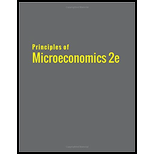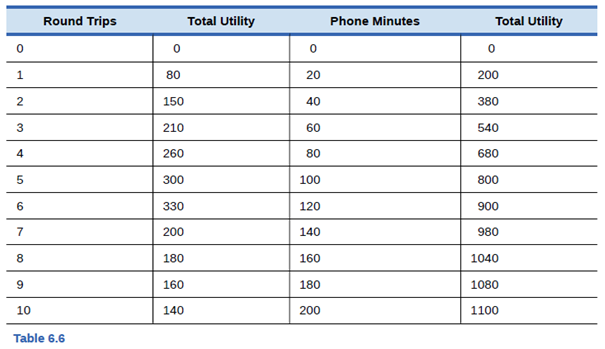
Jeremy is deeply in love with Jasmine. Jasmine lives where cell phone coverage is poor, so he can either call her on the land-line phone for five cents per minute or he can drive to see her, at a round—trip cost of

Using the values in given table, find out the points on Jeremy’s consumption choice budget constraint and identify his utility maximizing point?
Answer to Problem 1SCQ
The maximum total utility is 1120 on round 1 with 80 utility and 160 minutes of phone minutes within the given $10.
Explanation of Solution
It is given that Jeremy has total $10 to spend ,a round trips costs him $2 and phone calls costs $0.05 per minute. With the given money, he can either go for 5 round trips or no phone calls. second option is no round trips and 200 minutes of phone calls. there can be the combination of two in between. hence the budget constraint formulae is
Total amount=Price of round trips*Quantity of round trips+ Price of phone calls*Quantity of phone calls
A =P(r)*Q(r)+P(pc)*Q(pc)
$10=$2*Q(r)+$0.05*Q(pc)
dividing the whole equation by $0.05
$10/0.05=($2*Q(r)+$0.05*Q(pc))/0.05
200= 40*Q(r)+Q(pc)
Q(pc)=200-40*Q(r)
Hence with the given budget constraint and table, below table is constructed which shows zero to five round trips and how many phone minutes can be afforded with the given budget with total utility of each.
Concept introduction:
Budget Constraint: It represent all the possible combination of goods and services that a consumer can purchase with the given prices and income.
Want to see more full solutions like this?
Chapter 6 Solutions
PRINCIPLES OF MICROECONOMICS (OER)
Additional Business Textbook Solutions
Managerial Accounting (4th Edition)
Construction Accounting And Financial Management (4th Edition)
Horngren's Accounting (12th Edition)
Horngren's Accounting (11th Edition)
Principles of Accounting Volume 1
Cost Accounting (15th Edition)
- Digital Apps per Period 0 1 2 3 4 5 Total Utility of Digital Apps per Period (utils) which 0 50.0 95.0 135.0 171.5 200.0 Marginal Utility (utils) 50.0 45.0 40.0 36.5 28.5 Marginal Utility Portable per Dollars Spent Power Banks (price = $5.97) per Period | 8.4 7.5 6.7 6.1 4.8 0 1 GTA W N 3 4 5 Total Utility of Portable Power Banks per Period (utils) 0 25 47 65 80 89 Marginal Utility (utils) 25 22 18 15 9 Marginal Utility per Dollars Spent (price = $2.70) 9.3 8.1 6.7 5.6 3.3 Consider the table above. Suppose the consumer's income is $26. Does the consumer spend all of her income if she purchases the optimal quantities of digital apps and portable power banks? The optimum quantity of digital apps purchased is and the optimum quantity of portable power banks purchased is. (Enter your responses as whole numbers.) Spending on digital apps is $ and spending on portable power banks is $. (Enter your responses rounded to one decimal place.) Thus, total spending at the consumer optimum is $ the…arrow_forwardAlex, who was convinced that "Football is coming home", was very excited for the World Cup last year. Unfortunately, he realized that his favourite Paul Gascoigne jersey from Euro 1996 was getting old, so he wanted to buy a new one before England's first game the following week. He could either buy a 2014 James Milner shirt from retailer A, which would make him totally happy (utility=1), or a 2006 David Beckham shirt from retailer B, which gives him a utility of 0.8. However, the shirts are not available today. There is a 50% chance that retailer A will have the shirt on the week-end, and 70% chance that retailer B will have theirs on the week-end. Due to time and work constraints, Alex can only visit one of these retailers before the tournament starts, otherwise he will have to keep his old 1996 shirt, which gives him a utility of 0.5. He can also ask his friend Nathan to check both places in the morning. But being a Welsh supporter, Nathan will not do it for free and wants some…arrow_forwardAlex, who was convinced that "Football is coming home", was very excited for the World Cup last year. Unfortunately, he realized that his favourite Paul Gascoigne jersey from Euro 1996 was getting old, so he wanted to buy a new one before England's first game the following week. He could either buy a 2014 James Milner shirt from retailer A, which would make him totally happy (utility=1), or a 2006 David Beckham shirt from retailer B, which gives him a utility of 0.8. However, the shirts are not available today. There is a 50% chance that retailer A will have the shirt on the week-end, and 70% chance that retailer B will have theirs on the week-end. Due to time and work constraints, Alex can only visit one of these retailers before the tournament starts, otherwise he will have to keep his old 1996 shirt, which gives him a utility of 0.5. He can also ask his friend Nathan to check both places in the morning. But being a Welsh supporter, Nathan will not do it for free and wants some money…arrow_forward
- Enrique is a movie buff. He likes to watch on demand movies from his cable company, which cost $5 each, and so likes to go to the local movie house, which charges $15 a ticket. Suppose that given his budget and his tentative spending plans, the marginal utility from a cable movie is 15 utils and the marginal utility of a movie at the local cinema is 45 utils. Assuming he is spending his entire budget, Enrique is currently maximizing his utility Enrique can increase his utility by buying more cable movies and watching fewer cinema movies Enrique can increase his utility by buying more cinema movies and fewer cable moviesarrow_forwardSuppose you have $10, which you can wager in a game called "double or quits." In this game, you roll a fair die. If you roll a 4, 5, or 6, you win the game, getting back your $10 plus $10 more for a total of $20. If you roll a 1, 2, or 3, you lose the game and your $10. Your utility function is shown on the following graph Utility 10 20 Income According to this graph of your utility function, would you be considered risk-averse or a risk-taker? Why? Risk averse because of increasing marginal utility of income Risk taker because of increasing marginal utility of income Risk taker because of diminishing marginal utility of income O Risk averse because of diminishing marginal utility of incomearrow_forwardBecky needs to decide how many cups of coffee and pieces of cake she will buy for a meeting with an office mate. She estimates her total utility for different quantities of coffee and cakes below. A cup of coffee is $1.00, and each piece of cake is $0.50. Becky has a total of $3 to spend. What is Becky's total utility if she buys 1 cup of coffee and 4 pieces of cake? Cups of Coffee 1 2 3 4 5 6 Utility from Consumption Pieces of Cake 1 2 3 4 5 6 A B C D Total Utility from Cups of Coffee 33 56 79 Total Utility from Pieces of Cake 15 32 48 63 77 90 Total Utility of Different Consumption Bundles Consumption Bundle Cups of Coffee Pieces of Cake Total Utility 3 0 2 2 1 4 0 6arrow_forward
- Need asap please and thank you.arrow_forwardSean is arguing with his girlfriend, Yvette. They have been going out for a little more than two years. YVETTE: I'm leaving you, Sean. Get over it. SEAN: Are you saying that being single will make you happier than you've been with me? Speaking personally, I think the utility we've had in this relationship was much more than you could have had if you'd been single this whole time! YVETTE: I had taken an economics class and the word "utility" rings a bell. It's not that at all. We've had a fine time. It's that the utility I would get by continuing our relationship isn't worth it anymore. SEAN: I've never been dumped by someone citing the law of before. You're a piece of work, you know that? Yvette doesn't hear. She has already walked off, leaving Sean feeling like something of a sunk cost.arrow_forwardsolve the question given in the image.arrow_forward
- Today, you've decided to treat yourself to some dessert, so you go to the store to buy a doughnut or a cupcake. The utilities of one doughnut and one cupcake are 1212 and 2424, respectively.Given that the price of one doughnut is $6$6, what should be the price of a cupcake to get the same utility per dollar spent? Enter your answer in the box below and round to two decimal places if necessary.arrow_forwardWhen consumers have a budget, their utility is maximized by buying a combination of goods such that the marginal utility per dollar is the same for all of these goods. This is because if this were not the case, it would mean that the consumer hadn't used up their entire budget. of their insatiability. if a consumer could get higher marginal utility from one good than from others, they would want to buy more of that good, and less of others. if a consumer could get higher marginal utility from one good than from others, they would want to buy less of that good, and more of others. it guarantees them some variety.arrow_forwardKim has $24 per week in her entertainment budget. She splits her time between going to the movies and yoga classes. Each movie costs $8 while each yoga class costs $3. The total utility from each of these activities is set out in the table below. What is Kim's total utility maximizing point? Movies Total Utility Yoga Classes Total Utility 0 2 3 درا 4 5 0 40 75 105 130 160 0 1 2 3 4 1 6 7 8 Ruona classes 0 30 55 76 92 106 114 116 117arrow_forward
 Principles of Economics 2eEconomicsISBN:9781947172364Author:Steven A. Greenlaw; David ShapiroPublisher:OpenStax
Principles of Economics 2eEconomicsISBN:9781947172364Author:Steven A. Greenlaw; David ShapiroPublisher:OpenStax
 Microeconomics: Principles & PolicyEconomicsISBN:9781337794992Author:William J. Baumol, Alan S. Blinder, John L. SolowPublisher:Cengage Learning
Microeconomics: Principles & PolicyEconomicsISBN:9781337794992Author:William J. Baumol, Alan S. Blinder, John L. SolowPublisher:Cengage Learning Economics (MindTap Course List)EconomicsISBN:9781337617383Author:Roger A. ArnoldPublisher:Cengage Learning
Economics (MindTap Course List)EconomicsISBN:9781337617383Author:Roger A. ArnoldPublisher:Cengage Learning
 Exploring EconomicsEconomicsISBN:9781544336329Author:Robert L. SextonPublisher:SAGE Publications, Inc
Exploring EconomicsEconomicsISBN:9781544336329Author:Robert L. SextonPublisher:SAGE Publications, Inc





